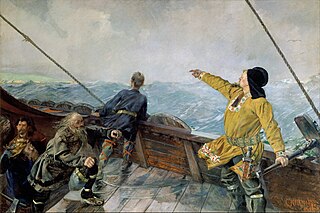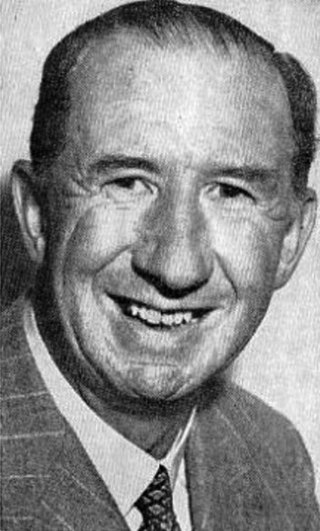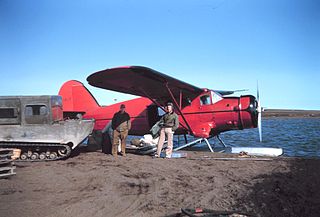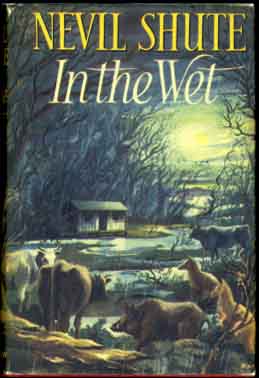Plot summary
The principal character is a young Scottish pilot with bush-flying experience in Canada, Donald Ross, who is hired by an Oxford don, Cyril Lockwood, to pilot an air survey mission of Brattalid in Greenland. Lockwood's interest is in the early Viking seafarers and their exploits, and although he appears to have little knowledge of the needs of such a project, he insists on their starting as soon as possible, with his elder brother David, a businessman, providing finance.
Ross, as the hired expert, then has to contend with the 'helpful' suggestions from both the financier and Lockwood's young daughter, Alix. This causes early tensions in the preparatory stages.
While the preliminary dig is ongoing Ross shoulders much responsibility including keeping the aircraft safe in a tidal zone. Worn out with the expedition's work – all of which has fallen solely on him – and a prolonged lack of sleep induced by worry over the expedition, he enters a coma induced by the sleeping tablets he has been forced to take to keep going, and in it dreams that he and Alix were once Scottish slaves aboard Leif Ericson's vessel on its voyage of discovery to Greenland. A part of this dream includes the leaving behind by the two slaves of a stone, with their names carved on it, at the Viking explorers' landing point in North America.
Ross recovers and tells Alix and the don of his dreams. The last remnant of photographic survey is successfully completed, and the three complete their air crossing to North America, making landfall in eastern Canada. Flying down the coast towards New York Ross recognizes where he dreamed Leif Ericson's expedition landed on the coast of Cape Cod; they land to investigate and find the stone with the slaves' names on it.
The technical details of a trans-Atlantic flight of this period (late 1930s) are accurate and of interest. The type of aircraft is a fictional radial-engined floatplane intended for bush use, made by a fictional Detroit firm named Cosmos. It corresponds roughly to the performance of a Noorduyn Norseman.
This was Shute's first attempt at re-incarnation as a plot, a second later work on this theme is In the Wet .

Vinland, Vineland, or Winland was an area of coastal North America explored by Vikings. Leif Eriksson landed there around 1000 AD, nearly five centuries before the voyages of Christopher Columbus and John Cabot. The name appears in the Vinland Sagas, and describes Newfoundland and the Gulf of Saint Lawrence as far as northeastern New Brunswick. Much of the geographical content of the sagas corresponds to present-day knowledge of transatlantic travel and North America.

Nevil Shute Norway was an English novelist and aeronautical engineer who spent his later years in Australia. He used his full name in his engineering career and Nevil Shute as his pen name, in order to protect his engineering career from inferences by his employers (Vickers) or from fellow engineers that he was "not a serious person" or from potentially adverse publicity in connection with his novels, which included On the Beach and A Town Like Alice.

Erik Thorvaldsson, known as Erik the Red, was a Norse explorer, described in medieval and Icelandic saga sources as having founded the first European settlement in Greenland. Erik most likely earned the epithet "the Red" due to the color of his hair and beard. According to Icelandic sagas, Erik was born in the Jæren district of Rogaland, Norway, as the son of Thorvald Asvaldsson; to which Thorvald would later be banished from Norway, and would sail west to Iceland with Erik and his family. During Erik's life in Iceland, he married Þjódhild Jorundsdottir and would have four children, with one of Erik's sons being the well-known Icelandic explorer Leif Erikson. Around the year of 982, Erik was exiled from Iceland for three years, during which time he explored Greenland, eventually culminating in his founding of the first successful European settlement on the island. Erik would later die there around 1003 CE during a winter epidemic.

Leif Erikson, also known as Leif the Lucky, was a Norse explorer who is thought to have been the first European to set foot on continental America, approximately half a millennium before Christopher Columbus. According to the sagas of Icelanders, he established a Norse settlement at Vinland, which is usually interpreted as being coastal North America. There is ongoing speculation that the settlement made by Leif and his crew corresponds to the remains of a Norse settlement found in Newfoundland, Canada, called L'Anse aux Meadows, which was occupied approximately 1,000 years ago.

Freydís Eiríksdóttir was an Icelandic woman said to be the daughter of Erik the Red, who figured prominently in the Norse exploration of North America as an early colonist of Vinland, while her brother, Leif Erikson, is credited in early histories of the region with the first European contact. The medieval and primary sources that mention Freydís are the two Vinland sagas: the Saga of the Greenlanders and the Saga of Erik the Red. The two sagas offer differing accounts, though Freydís is portrayed in both as a strong woman.

The Norse exploration of North America began in the late 10th century, when Norsemen explored areas of the North Atlantic colonizing Greenland and creating a short term settlement near the northern tip of Newfoundland. This is known now as L'Anse aux Meadows where the remains of buildings were found in 1960 dating to approximately 1,000 years ago. This discovery helped reignite archaeological exploration for the Norse in the North Atlantic. This single settlement, located on the island of Newfoundland and not on the North American mainland, was abruptly abandoned.

The Saga of Erik the Red, in Old Norse: Eiríks saga rauða, is an Icelandic saga on the Norse exploration of North America. The original saga is thought to have been written in the 13th century. It is preserved in somewhat different versions in two manuscripts: Hauksbók and Skálholtsbók.

Markland is the name given to one of three lands on North America's Atlantic shore discovered by Leif Eriksson around 1000 AD. It was located south of Helluland and north of Vinland.

No Highway is a 1948 novel by Nevil Shute. It formed the basis of the 1951 film No Highway in the Sky.

Wilfrid Reid "Wop" May, was a Canadian flying ace in the First World War and a leading post-war aviator. He was the final Allied pilot to be pursued by Manfred von Richthofen before the German ace was shot down on the Western Front in 1918. After the war, May returned to Canada, pioneering the role of a bush pilot while working for Canadian Airways in Northern Alberta and the Northwest Territories.

Brattahlíð, often anglicised as Brattahlid, was Erik the Red's estate in the Eastern Settlement Viking colony he established in south-western Greenland toward the end of the 10th century. The present settlement of Qassiarsuk, approximately 5 km (3.1 mi) southwest from the Narsarsuaq settlement, is now located in its place. The site is located about 96 km (60 mi) from the ocean, at the head of the Tunulliarfik Fjord, and hence sheltered from ocean storms. Erik and his descendants lived there until about the mid-15th century. The name Brattahlíð means "the steep slope". The estate, along with other archeological sites in southwestern Greenland, was inscribed on the UNESCO World Heritage List in 2017 as Kujataa Greenland: Norse and Inuit Farming at the Edge of the Ice Cap.

Bush flying refers to aircraft operations carried out in the bush. Bush flying involves operations in rough terrain where there are often no prepared landing strips or runways, frequently necessitating that bush planes be equipped with abnormally large tires, floats, skis or any other equipment necessary for unpaved runway operation. It is the only viable way of delivering people and supplies into more difficult to reach, remote locations.

Bernt Balchen was a Norwegian pioneer polar aviator, navigator, aircraft mechanical engineer and military leader. A Norwegian native, he later became an American citizen and was a recipient of the Distinguished Flying Cross.

Thorfinn Karlsefni Thórdarson was an Icelandic explorer. Around the year 1010, he followed Leif Eriksson's route to Vinland in a short-lived attempt to establish a permanent settlement there with his wife Gudrid Thorbjarnardóttir and their followers.

In the Wet is a novel by Nevil Shute that was first published in the United Kingdom in 1953. It contains many of the typical elements of a hearty and adventurous Shute yarn such as flying, the future, mystic states, and ordinary people doing extraordinary things.

The Viking is a 1928 American synchronized sound drama film. While the film has no audible dialog, it was released with a synchronized musical score with sound effects using the sound-on-film Western Electric Sound System process. This film was the first feature-length Technicolor film that featured a soundtrack, and it was the first film made in Technicolor's Process 3. It stars Pauline Starke, Donald Crisp, and LeRoy Mason. The film is loosely based on the 1902 novel The Thrall of Leif the Lucky by Ottilie A. Liljencrantz. The Viking was directed by Roy William Neill.

Vinland the Good is a description of Vinland which appears in the two sagas, Greenlanders' Saga and Saga of Erik the Red. The term has been used as the title of two works of fiction by British authors.

The Rainbow and the Rose is a novel by Nevil Shute. It was first published in England in 1958 by William Heinemann.

Aarohi Pandit is an Indian pilot. In 2019, she became the world's first woman pilot and the youngest pilot-at the age of 23-to cross the Atlantic Ocean and the Pacific Ocean solo in a light sport aircraft.
















